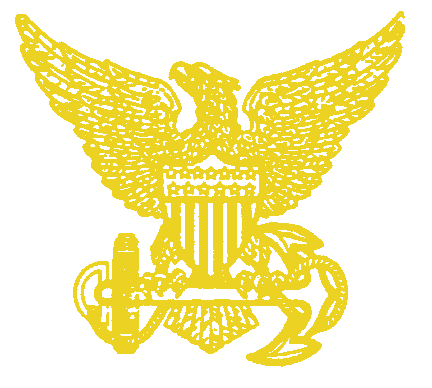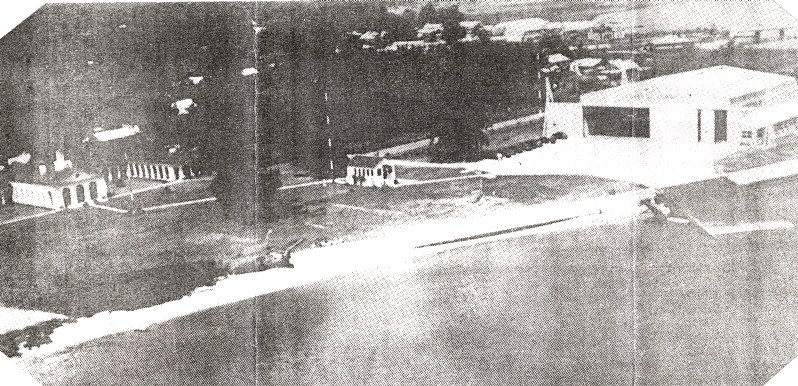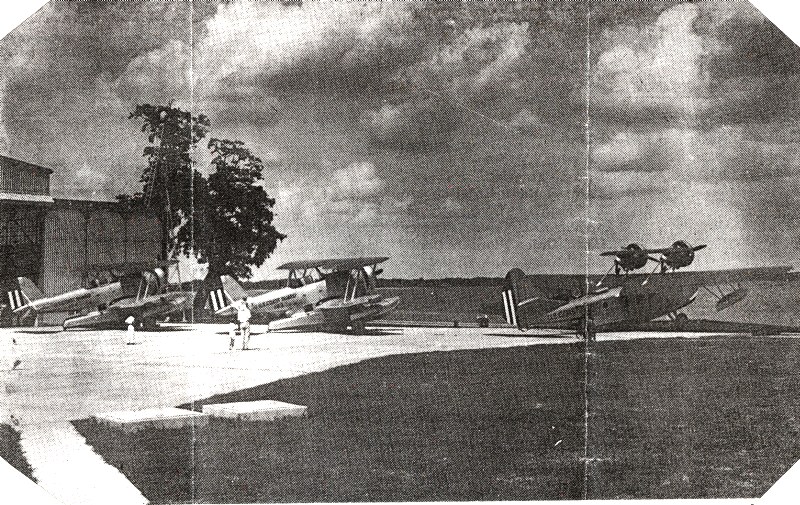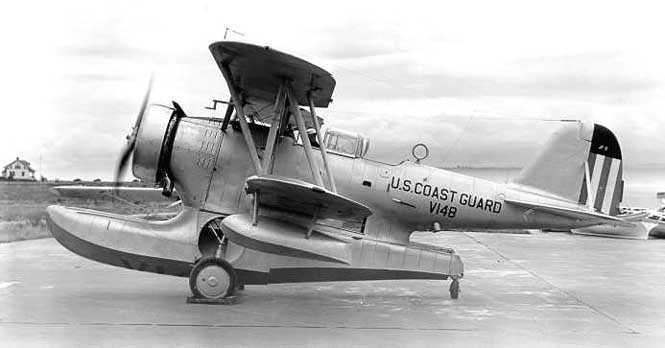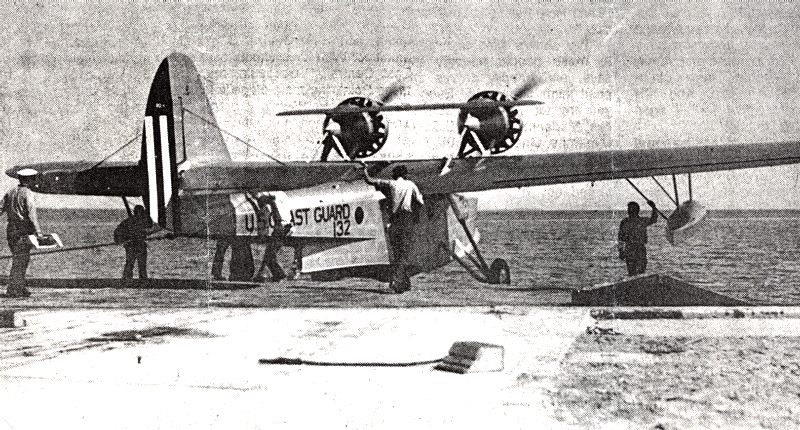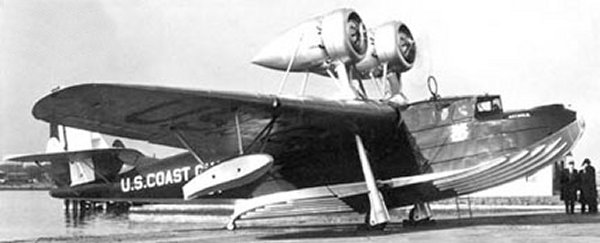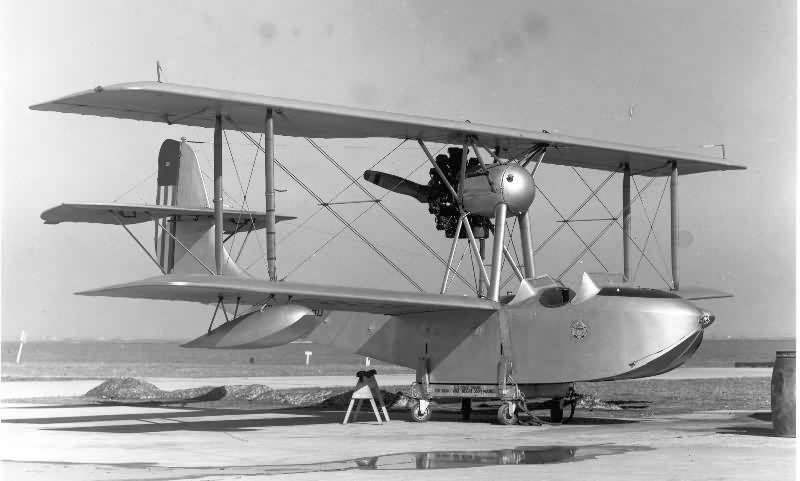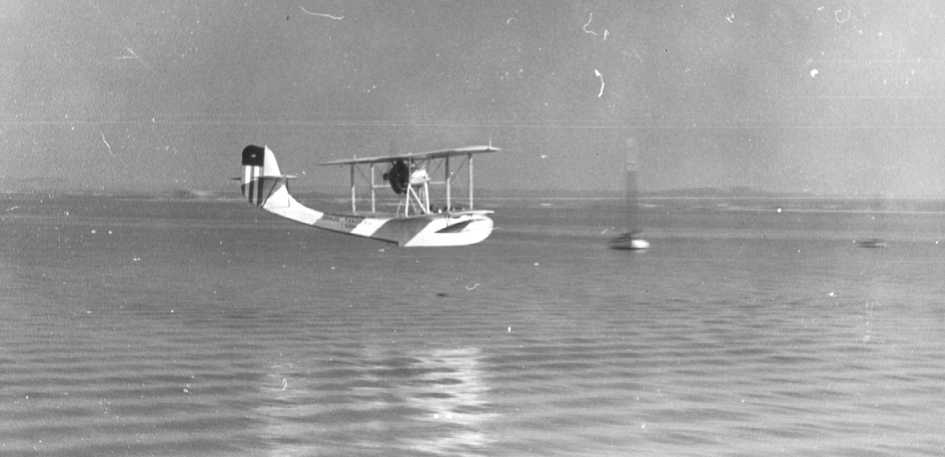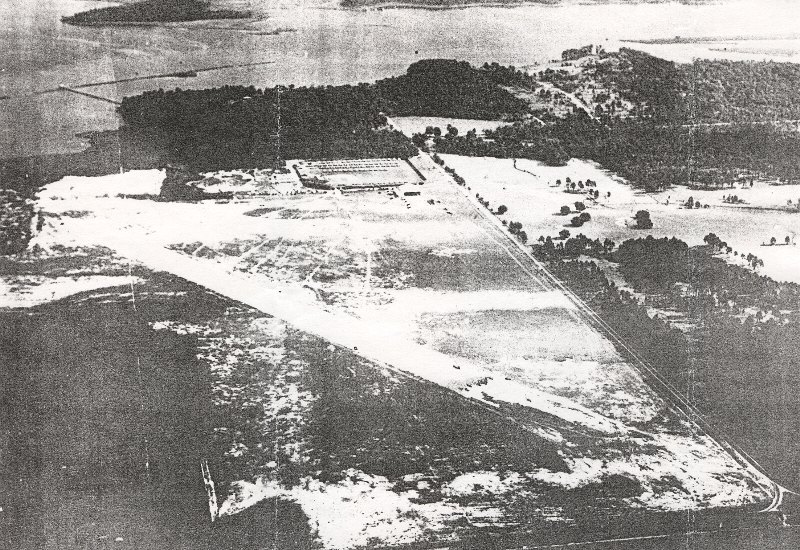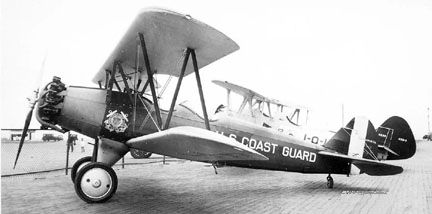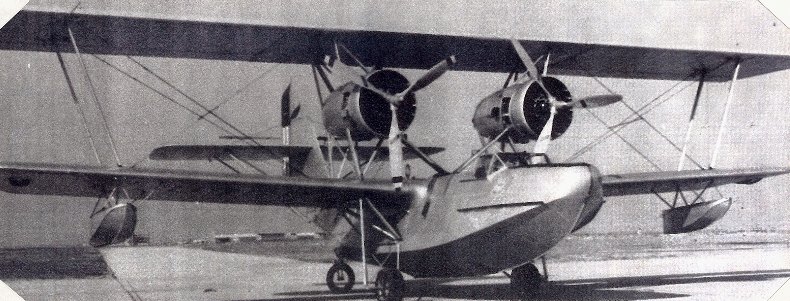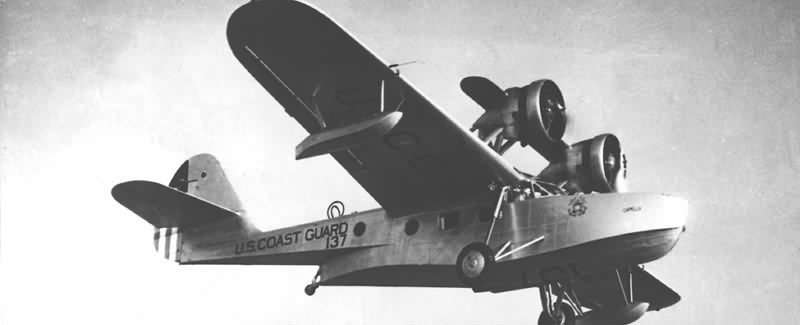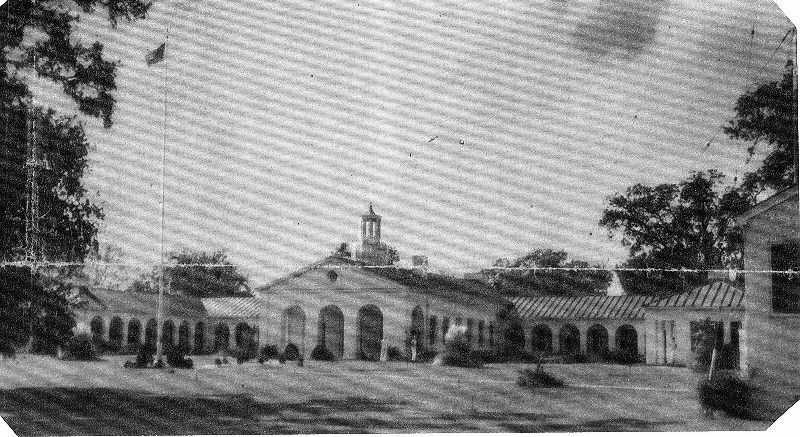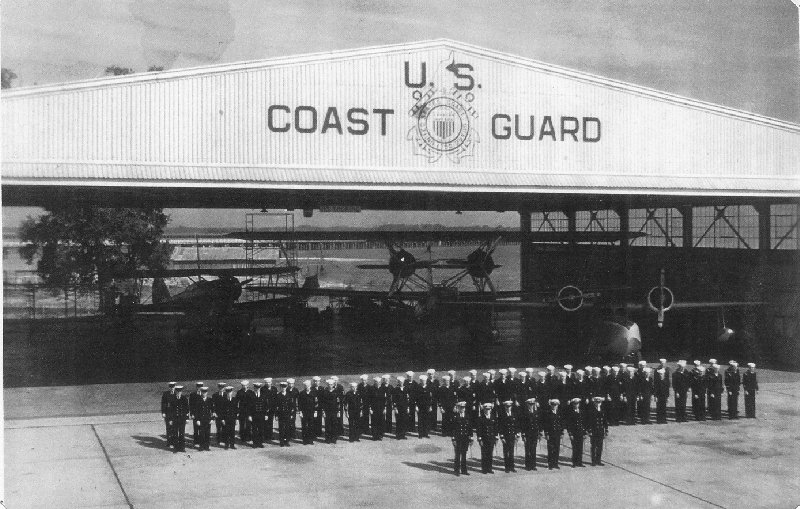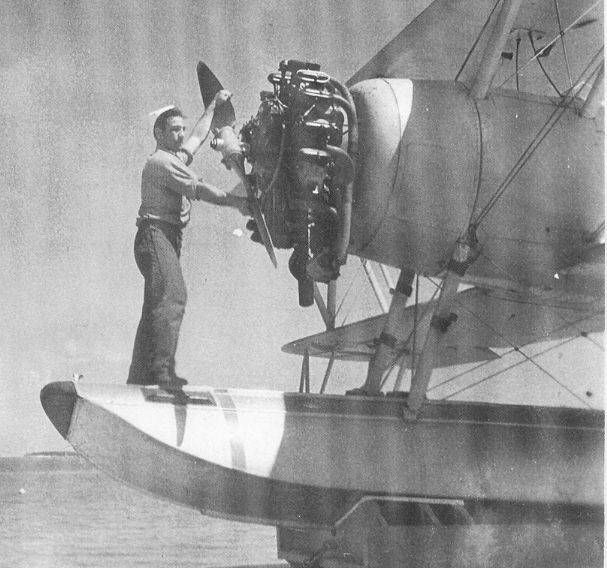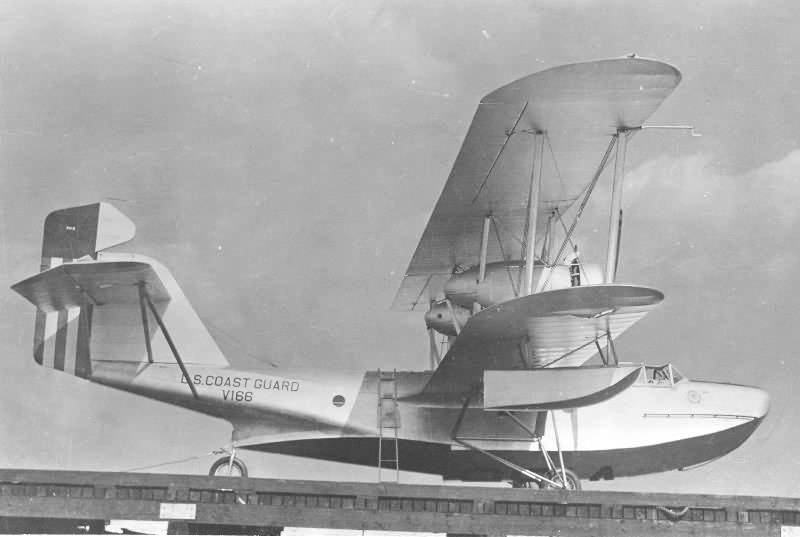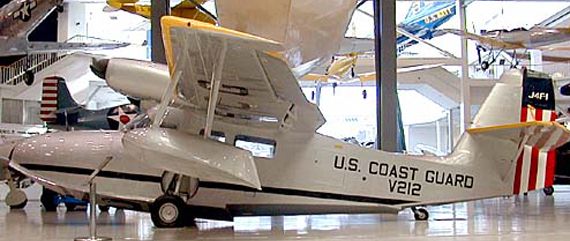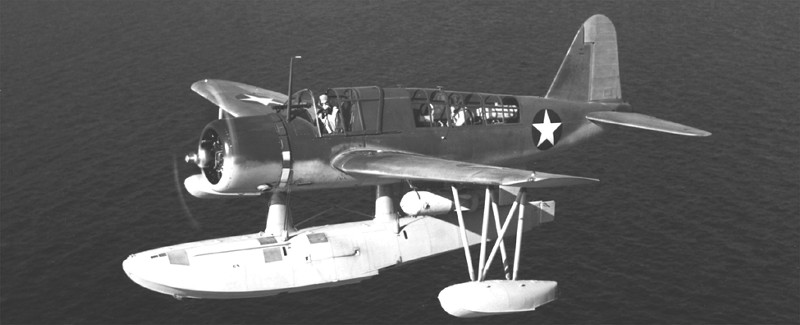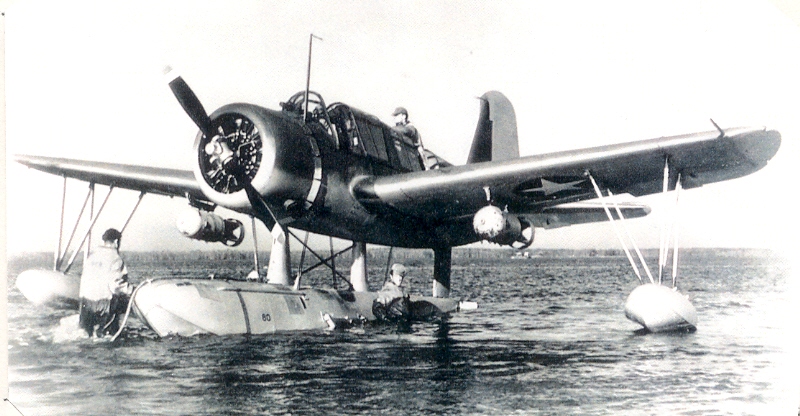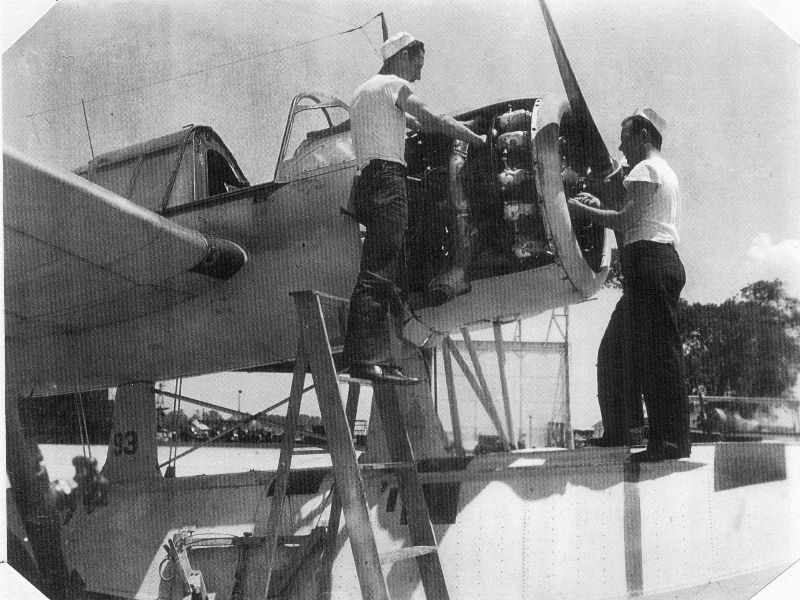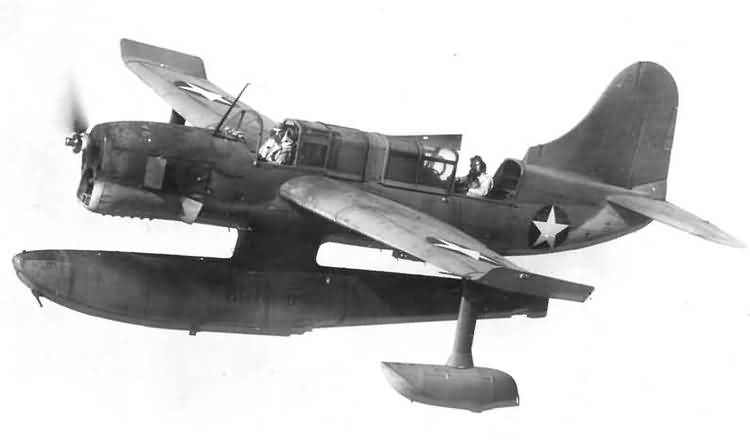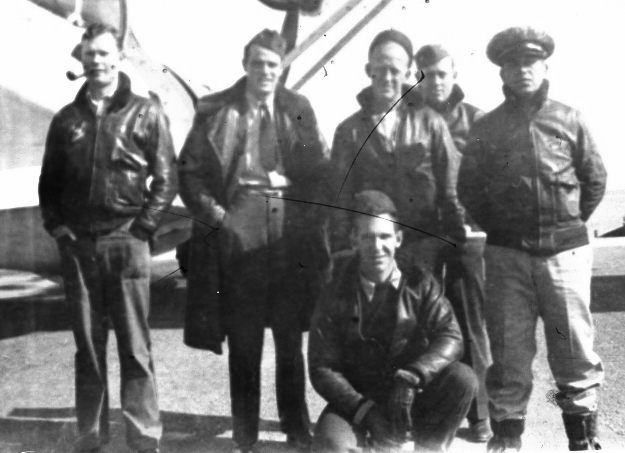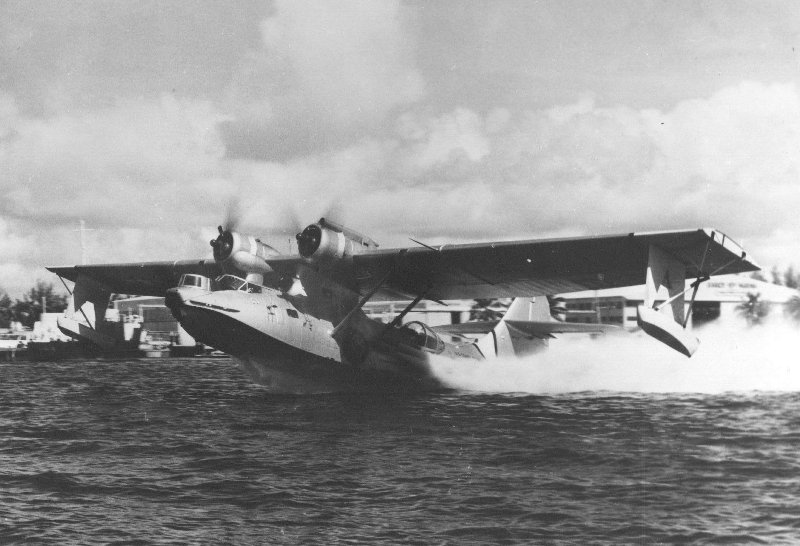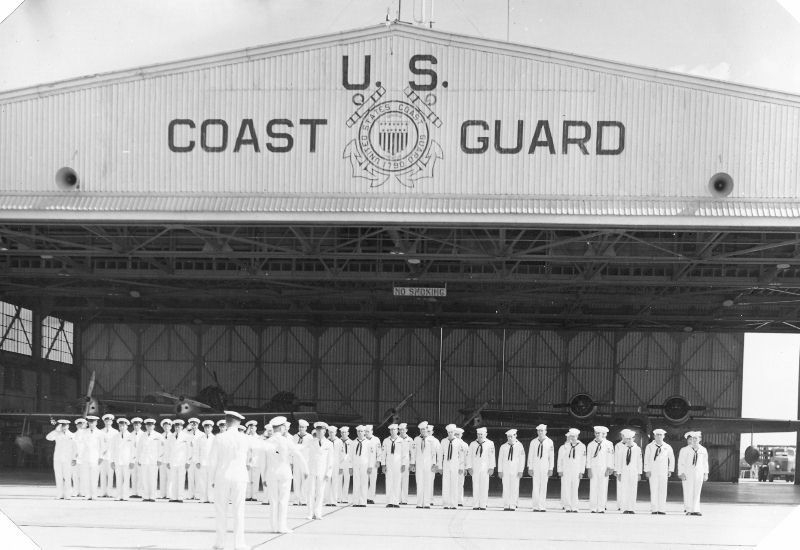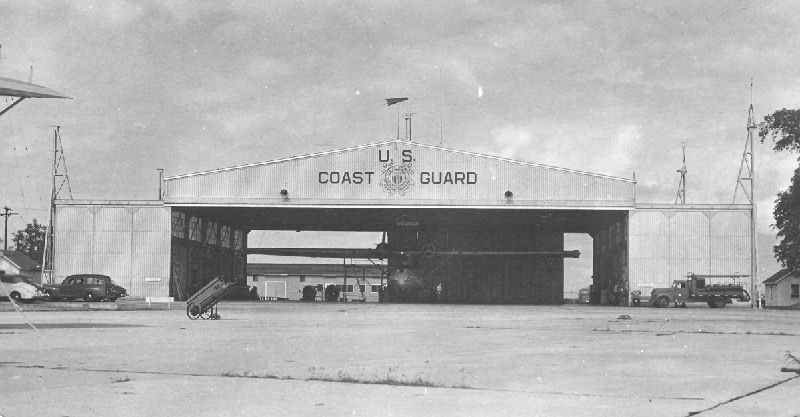|
Click Here for a 3mb printable version of this article, complete with all photos, in MSWord.
Two recent publications, History of Coast Guard Aviation, by Arthur Pearcy, 1989, and U.S. Coast Guard Aviation 1916-1996, Turner Publishing Co, 1997, have only five one line references to the Coast Guard Air Station, Biloxi, Mississippi. The Air Station at Biloxi was in commission from December 1934 through March 1947, and the Coast Guard maintained a presence in Biloxi with a one-plane detachment at Keesler Air Force Base, Mississippi, from 1947 until 1966. As a former Coast Guard Aviation Machinist Mate briefly stationed at Biloxi following service at sea as a Quartermaster in WWII, I believe there are more than five lines of information worthy of remembrance of the first Coast Guard Air Station located on the shores of the Gulf of Mexico. I have attempted to compile some interesting information on operations and the men who served at Biloxi. Unfortunately I may have waited too long to start. So many of my shipmates have passed on, and searching for both printed and verbal personal memories has been a difficult task. I have also found that the Coast Guard, during those years, could not afford a very effective Public Information Division, so researching newspapers and other publications has been disappointing. People did not have the inexpensive cameras and film processing we do today, so photos are also almost impossible to find. Of course, that may also be due to the fact that personnel involved in a rescue mission were always more involved in performing the mission than attempting to record it! As far as getting memories like this one down on paper, many people have told me, "I just can't write it down." I used to say the same thing, until I started thinking of an answer back in 1978 to my grown son's question, "So, what did you do in the Coast Guard and the Air Force back in the dark ages?" It seemed at the time that I'd never be able to "write it down," but I received encouragement from many people. While many of you reading this may think you can't "write it down" either, you can - I have put together more than twenty articles about my experiences and those of my shipmates. They don't sell in the popular press, but they do result in renewing friendships from those olden days, and making new friends as well. Write down what you know, and
write what you've heard! I have kicked myself
many times for not recording the stories I heard
from my father, who served on Coast Guard destroyers
as well as "six bitters" during the Prohibition
Wars, and on 165 and 240 foot cutters during his
24-year career in the U.S. Coast Guard.
A BRIEF HISTORY OF THE U.S. COAST GUARD In the year 1790 the Revolutionary War for Independence had recently ended and our young country was nearly one hundred million dollars in debt. A sea going law enforcement agency was needed to curtail smuggling and ensure that the newly implemented tariffs and customs taxes would be collected to aid in paying off this debt and to provide money to operate the government. To this end Alexander Hamilton, the new Secretary of the Treasury, established both the Treasury Department and the Revenue Marine, a sea-going force of 10 vessels. By 1796 Hamilton had placed our new nation on firm financial footing and had paid off the Revolutionary War debt. In 1885, the Revenue Marine
became the Revenue Cutter Service. In 1915,
the Treasury Department combined its Life Saving
Service, founded in 1847, with the Revenue Cutter
Service to form the United States Coast Guard.
THE
PROHIBITION WAR The Coast Guard also fought one very unpopular war in which the other Armed Forces did not participate. In 1917, Republican Andrew J. Volstead, Congressman from Minnesota, introduced a bill that carried his name "The Volstead Act". It was passed by Congress, vetoed by President Woodrow Wilson, but passed over his veto. Ratified by the states, the Volstead Act became the law of the land on 17 January 1920 as the 18th Amendment to the Constitution. Prohibition was in effect! The Coast Guard was then charged with stopping the "illicit import," that is to say, smuggling, of liquor along the nation's sea coasts;. New operating bases, new boats and ships were built to fight what was to become known as "The Prohibition War." One such operating base was Base 15 at Biloxi, Mississippi, located on Biloxi Back Bay on land known as the Naval Reserve. Commissioned in 1925 with Captain S.P. Edmonds in command, it eventually had over 125 personnel, twelve 75-foot patrol boats, six 38-foot high-speed picket boats, the 125-foot patrol boat, WOODBURY, and the larger 165-foot cutter, TRITON. Prohibition proved to be very unpopular, difficult to enforce, and very costly in terms of tax revenue lost. On December 5, 1933, the 21st Amendment was ratified, and prohibition was repealed. With the end of the "war on booze," Base 15 at Biloxi, then under the command of LT F. P. Vellerick, was decommissioned on 2 June 1933. Vessels and personnel were transferred to the operating base at Pasacagoula, Mississippi, which then became Base 15. Many of the vessels used in the Prohibition War were placed in storage, and Coast Guard manning was reduced.
COAST GUARD
AVIATION At first, it appeared that the Coast Guard, relieved of its Prohibition War responsibilities, would leave Biloxi, ending its presence there after more than eight years. However, another prime Coast Guard responsibility, "the saving of lives at sea," although it had never really been set aside during Prohibition, once again took on more importance. To the ever-increasing shipping traffic in the Gulf of Mexico, air travel over water was becoming more common. Coast Guard Aviation was also growing as newer aircraft provided increased capabilities to the service. However, the Gulf of Mexico at that time had no facilities along its shores from which Coast Guard Aviation could operate. To provide more effective life saving using aircraft along the south coast, Coast Guard officials began a search for locations to place Air Stations. Each would be equipped with a radio station and three or four amphibians or seaplanes, several of which would be classified as Air Ambulances. These aircraft, capable of not only conducting aerial searches over the vast Gulf waters, were also able to land at sea, pick up ill or injured patients, and return them to needed medical care. One well-situated site was Biloxi, Mississippi. The Coast Guard team of LCDR C. G. von Paulsen, W. R. Kenley and M. P. Ulte conferred with Biloxi City Commissioners to find waterfront property suitable for an air station. The City fathers made the six acre Point Cadet Park available. It was ideally suited for an amphibian base, located on Biloxi's eastern edge with direct access to Biloxi Bay. On 21 September 1933, Mississippi Senator Pat Harrison and City Commissioner John Swanzy announced that President F. D. Roosevelt had signed the bill authorizing $290,000 for construction of the Coast Guard Air Station, Biloxi, Mississippi. Initially, $100,000 of Public Works Administration funds were made available to begin clearing the land, dredging of Biloxi Bay, building a concrete seawall and constructing a seaplane ramp. Also included was the construction of the 120 X 100 foot steel-framed, asbestos-sided hangar, with offices and maintenance shops along each side. In addition, there were the aircraft parking and operating areas to be built, as well as the radio station. Bids were opened and the winner, B. Knost and Company of Pass Christian, MS, began construction in November 1933. The remaining $190,000 was spent in later years for a barracks, mess hall, garage and crash boat dock. Until the barracks and mess hall were completed in 1938, personnel had to find housing and messing in Biloxi.
In 1938, the Coast Guard Air Station had about 18 acres. Shown here is the 12,000 square foot hangar with offices and shops, the paved aircraft parking area, and the seaplane ramp. The small building at center is the radio station. Two wings of the E-shaped barracks and mess hall are at the left. The highway bridge across Biloxi Bay to Ocean Springs is visible above the hangar. Photo by Tony Ragusim.
COMMISSIONING
OF THE AIR STATION On 5 December 1934, the air station and Coast Guard Radio Station "NOX" were placed in commission, with LT W. S. Anderson as commanding officer. Lieutenant Anderson, Coast Guard Aviator #10, graduated in the First Coast Guard Aviation Class from Pensacola Naval Air Station, Florida, in 1916. A big ceremony was planned, including a fly-over by three large Navy patrol planes from Pensacola, ribbon cutting, and the arrival of the first two Coast Guard Grumman JF-2 amphibian aircraft. It was all to be covered by Fox Movietone news, but the event was cancelled due to very bad weather. Everything, that is, except the arrival of the Coast Guard amphibians. The first, JF-2 #163, was flown by LT CDR von Paulsen with Aviation Chief Machinist Mate Eddie English as crew member, and the second, JF-2 #164, flown by LT E. E. Fahey with ACMM P. D. Hinder as crew member. The Air Station was in operation!
The first three of many aircraft to be based at Biloxi Air Station sit at the ready while a visitor and his children look over everything. The two Grumman JF-2s (#163 and #164) are on the parking apron, while the Douglas RD-4 (#132) is at the ready position at the seaplane ramp. At the need to launch, the aircraft would taxi down the ramp into Biloxi Bay, retract the wheels, and make a take off from the water. On returning, it would land on the bay, extend the wheels, taxi up the ramp, be washed down with fresh water to remove the corrosive salt water, and be made ready for the next mission. Photo by Tony Ragusim.
On 23 February 1935, LT W. S. Anderson, Commanding Officer, and his aircrew landed the third aircraft, a Douglas amphibian RD-4, in Biloxi Bay. Fresh from the Douglas factory in Santa Monica, California, RD-4 #132 was a twin-engine, high wing monoplane with Pratt and Whitney R-1340-10 engines. The 60-foot wing was constructed of waterproof plywood while the all-metal fuselage was constructed of aluminum. Its fuselage was really a boat-like hull with positions for two pilots, an aviation radioman and a flight mechanic, plus room for several survivors in wire "stokes" stretchers. The RD-4 "Dolphin" #132 was also given the name "ALIOTH." Many of the early, larger Coast Guard aircraft were individually named for heavenly stars. The RD-4 had a range of 660 miles at 110 miles per hour, and cost $45,000 each. In 1936, #132 became V-127.
Coast Guard Aircraft RD-4 #132, named for the star Ailoth, makes ready for a mercy mission to assist someone in distress at sea. After the aircraft enters the water, the whells will be retracted to beneath the wing, and a water take-off sends it on the way. In this photo the water is perfect for operations. When the water is glassy smooth, a vacuum drag is created making a very long take-off run necessary. On landing, the pilot wold find it hard to determine just where the surface is. In these cases, a crash boat would run ahead of the aircraft, chopping up the water surface. On occasions, a strong wind from the west combined with a low tide would casue a very low ater table. This condition made it necessary to slowly taxi a long distance to find water deep enough to make a take-off. A landing would not be attempted. Under low water conditions, operation would sometimes shift to Biloxi Municipal airport. Photo by Tony Ragusim. 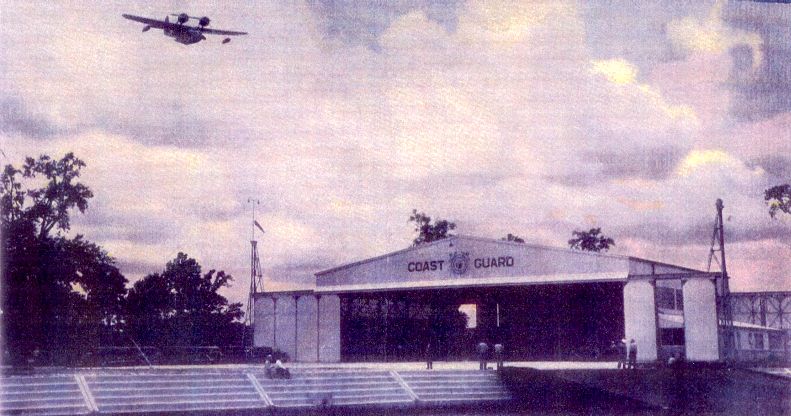 In 1936, Biloxi welcomed the arrival of a General Aviation "Flying Life Boat" PJ-2 #251 (V-116) seaplane. This large aircraft, named for the star Antares, had been a PJ-1 with engines and propellers pushing to the rear. In 1933, #251 was overhauled and the Pratt and Whitney R-1690 engines were turned around to face forward so the propellers pulled rather than pushed through the air. The PJ-2 was twin-engined, with a high mounted 74-foot plywood covered wing, and an aluminum boat-like hull. It had a retractable set of wheels and could taxi about on land and move up and down the seaplane ramp. However, the gear were not stressed for take off or landing on land, and so it was a seaplane, rather than an amphibian. Its range was 1000 miles at 110 miles per hour, and there were positions for two pilots, an Aviation Radioman, and two flight mechanic aircrew members. There were also provisions for three litters. The initial cost of the PJ-2 was $45,000.The Douglas RD-4 amphibian #132 "Ailoth" returns from a medical mercy mission during the summer of 1935. It passes over the hangar at Biloxi Air Station as it prepares to land in the Biloxi Bay Seadrome operating area. Ground crew members wait at the top of the seaplane ramp, while several civilan friends and relatives of the patient on the aircraft sit along the seawall. The Ailoth will land in the water, lower its landing gear, and taxi up the ramp. Ground crew members will secure the aircraft and assist in rmoving the patient for transfer to medical care in Biloxi. This photo was taken from the station crash boat, standing by in the bay. Photo by USCG
Referred to as a "Flying Lifeboat" (FLB), this seaplane carried the name of the star "Antares" A very rugged aircraft used only by the Coast Guard, it performed many offshore open sea landings on medical mercy missions. This aircraft began as a PJ-1 with Pratt and Whitney R-1340 engines and pusher propellers. It was modified in 1933 with Pratt and Whitney R-1690 engines and tractor propellers to become the only PJ-2. The original number FLB-51 was changed to V-116 in 1936. The 74-foot wing was constructed of plywood while the fuselage was aluminum. Note the stiffeners along the bottom of the hull. The built-in beaching gear was for ground handling only, and not stressed for take-off or landings. The blue fuselage and silver wing color scheme was later changed to overall aluminum color. Photo by USCG. 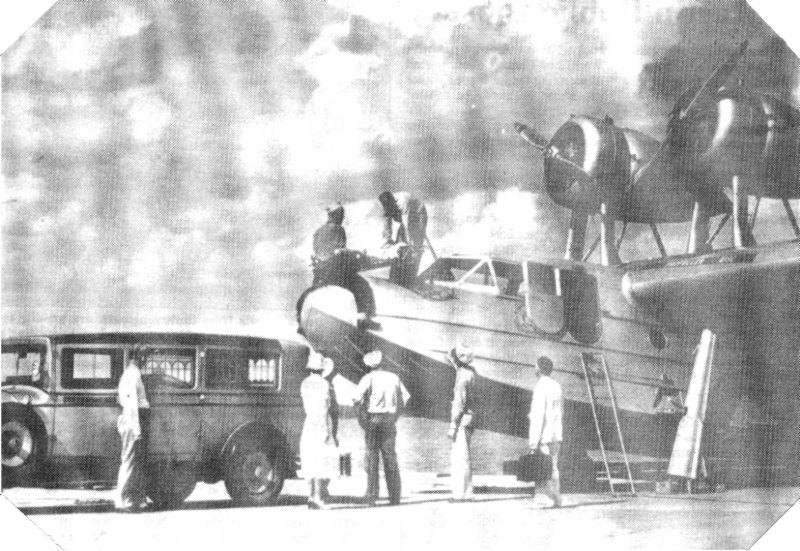 In 1936, Coast Guard aircrew members from CG Air Station Biloxi lower a patient in a stokes wire litter from the General Aviation Company PJ-2 FLB-51 to an awaiting medical team and ambulance for transport to the hospital. The patient was picked up from a merchant ship in the Gulf of Mexico after an open sea landing by the Coast Guard crew and aircraft. Photo by Tony Ragusim. 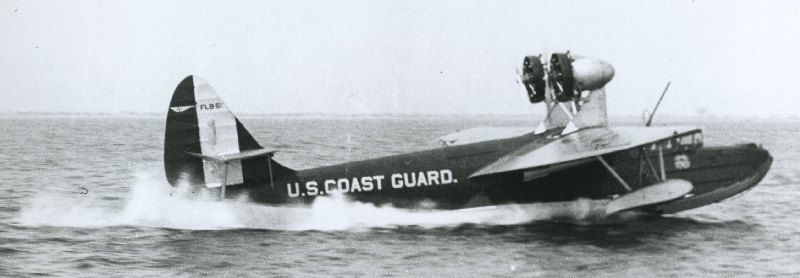 The 00-1 had a 400-mile range at 90 miles per hour. While ungainly in appearance, it was an excellent seaplane. A special beaching gear dolly was needed for movement about on land. Because of the open cockpits, it was referred to as the "Flying Bathtub."
An odd look at an odd looking aircraft. The French designed Hydravions-Schreck seaplane built in the U.S. by the Viking Flying Boat Company. This biplane had a 39-foot wing span, with 250 square feet of lifting surface. A singe R-760 seven cylinder radial engine with a seven-foot fixed wooden prop gave it a 100 MPH, 390 mile range. Given the designation OO-1, the Coast Guard purchased five of these four place aircraft. With two open cockpits, they were referred to as the "Flying Bath Tub". Despite it's odd look, open cockpits and wet water operations, it was an excellent aircraft, and one of the cheapest purchase by the Coast Guard, costing 7,000 each. All photos by USCG. 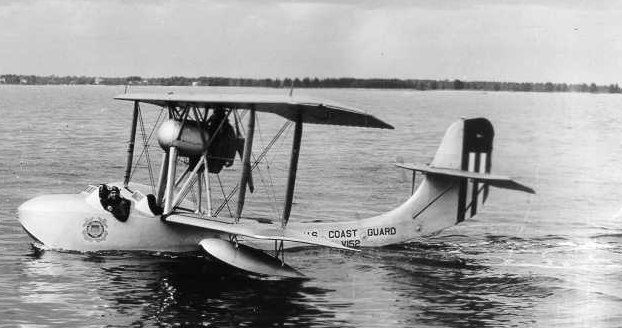
STORM WARNINGS FOR THE SHRIMPERS Aerial surveillance, looking for lost or disabled vessels, reporting wrecks and obstructions to navigation, emergency medical or mercy evacuation missions, and law enforcement missions were all part of Biloxi Air Station's responsibilities. Much of the commerce on the Gulf coast was then involved in commercial fishing, especially shrimping, and there was a large shrimp-boat fleet and packing houses located in Biloxi. Coast Guard flying operations from Biloxi provided important safety notification and assistance to this industry. In cases of bad weather and severe storms, or when the need arose to contact fishermen for emergencies at home, flights would be made to inform the "shrimpers," since radios were not in wide spread use among the fishermen. Radios of that era were expensive, required the operator to use Morse Code, and needed lots of specialized maintenance. So messages were delivered directly by Biloxi's aircraft, flying low and slow to accurately drop a floating yellow wooden message block with a long yellow cloth streamer attached. The streamer made the hollowed out block easily retrievable from the water - and the hand written message inside the block would be passed on to the addressee or to the fishing fleet. I participated in several of these flights in the late mid-1940s, and they weren't all milk runs. While dropping storm warnings in 1946, our JRF-5 #84791 amphibian's left engine suffered major damage when the internal crank shaft split in two, causing sudden engine stoppage. The pilot, LT G. E. McGovern, just managed to maintain control and make a forced landing from our 50-foot altitude into very turbulent waters. Our aircraft suffered severe damage and had to be towed some 60 miles back to Biloxi Air Station after the storm passed.
SOME EARLY RESCUE MISSIONS In 1937, LT CDR R.L. Raney, Coast Guard Aviator #39, became the new commanding officer and an additional 12 acres were added to the original six at the Air Station. In July 1937, with pilot LT CDR Raney, aviation machinist mate C.E. Bay, and aviation radioman F.W. Logue, PJ-2 V-116 "ANTARES" launched from Biloxi on a medical mercy mission. The oil tanker S.S. W. J. HUMPHREY, 200 miles southwest of Biloxi, had a seriously injured seaman aboard who needed evacuation. Taking off in late morning, the ANTARES located the tanker and made a successful water landing, transferring the patient, A. Toth, on board. However, rising winds and a rough sea prevented a take off. Pilot Raney attempted to taxi over 50 miles to the shelter of Timbalier Bay to the west of Grand Isle, Louisiana. The wind and sea conditions prevented this attempt, so Commander Raney headed for the shelter of the Southwest Pass, at the entrance to the Mississippi River. The 165-foot Coast Guard Cutter NIKE rendezvoused to escort the ANTARES, and after several hours, the aircraft arrived with no damage, but nearly out of aviation gas. RD-4 V-127 piloted by LT J. R. Henthorn, launched from Biloxi, and arrived at Southwest Pass to transfer enough fuel to the ANTARES for the return flight. Both aircraft then made successful takeoffs and landed safely at Biloxi Air Station about 8:00 that evening. Seaman Toth was transferred by ambulance to Biloxi Hospital, where he recovered. The full efforts of two rescue aircraft and aircrews, along with the assistance of the cutter NIKE made this a very successful mission. Sometimes our own Coast Guard sailors need assistance. In September 1938, two crew members aboard the cutter NIKE, then on patrol in the Gulf of Mexico, became seriously ill and in need of more medical attention than the cutter's pharmacist mate could give. Lieutenant Henthorn, piloting PJ-2 V-116, with three aircrew members, launched to rendezvous with the NIKE off the Mississippi Delta. A successful water landing was made, and patients C. Arrington and L. O. Prouse were transferred to V-116. The flight crew flew to Lake Pontchartrain, where they made another successful water landing, and the patients were transported to the Public Health Marine Hospital in New Orleans.
BILOXI'S 300-FOOT RUNWAY It wasn't always necessary to launch one of the Coast Guard aircraft to provide aid to an aviator in distress. Bob White owned the Piper aircraft dealership at the Biloxi Municipal Airport and also operated a flying school there. White was a former four-engine seaplane pilot for Pan American Airways, and flew his own J-2 Piper Cub on floats. Once, on a return flight to Biloxi from St. Petersburg, Florida, he phoned ahead to a friend telling him his engine had been acting up "but it was operating alright now." Just in case, he asked his friend to please notify the Coast Guard if he was late arriving at Biloxi. He almost needed the phone call. As White neared Biloxi, his engine again began having problems. He nursed his aircraft to the coast, managing an emergency landing in the Air Station's seaplane operating area. Obtaining a beaching attachment, the Coast Guardsmen towed the J-2 Piper Cub up the seaplane ramp, where White and a mechanic began to work on fixing the Cub's balky engine. Bob White and his mechanic were treated well by the Coast Guardsmen, with invitations to eat in the mess hall between long hours working on the airplane. Eventually, White found it necessary to remove the installed engine, and replace it with a smaller one. However, the smaller engine didn't have sufficient power to permit a water take off, so White removed the heavy floats and placed the Cub on landing wheels, intending to tow the aircraft across town to the airport. However, several problems prevented White from doing this, and he decided to take off from the Air Station's small paved maintenance and beaching area. After gaining permission and some assistance from the Coast Guard, White towed the J-2 to the extreme south end of the Air Station. There, he removed everything not absolutely needed for flight to lighten the load, and had several men hold the aircraft back while he set the engine at full power. Then, releasing the brakes and hold-back restraints, White made his take off run toward the seaplane ramp, successfully making his take off on the amphibious base's 300-foot long clear space. This probably gives Coast Guard Air Station Biloxi the honor of having shortest, and shortest-lived runway in the history of Coast Guard Aviation!
Above: The Biloxi Municipal Airport, 1939, with the National Guard encampment tents to the rear of the hangar, at the center of the photo. The T-shaped pier extending into Biloxi Back Bay was the City-owned pier used by the Coast Guard Base 15 during the 1925-1933 era of the Prohibition War. This is all now part of Keesler Air Force Base. The Coast Guard operated its NY4-1 V110 land plane from here and used the field in emergencies with its amphibians with water conditions restricted operation at the Air Station. Photo by Tony Rogusim. 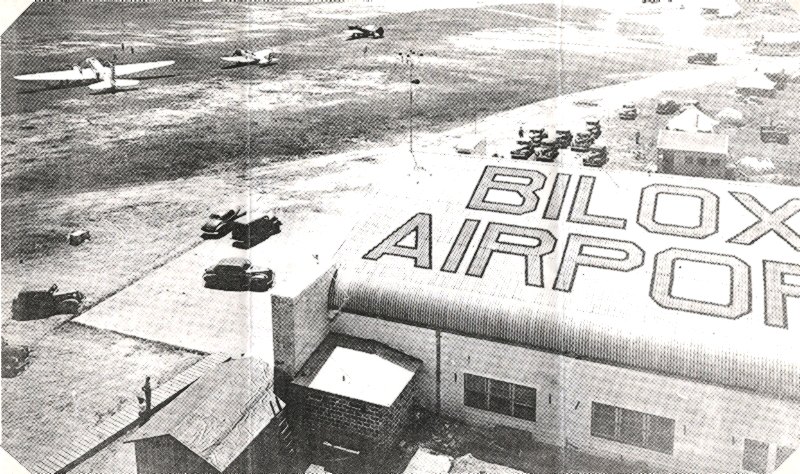
MORE AIRCRAFT ARRIVALS AND DEPARTURES In 1939, LT S. C. Linholm, Coast Guard Aviator #36, became the new commanding officer, and RD-4 V-127, the ALIOTH, was transferred to an overhaul facility in Hartford, Connecticut. A landplane, a Consolidated N4Y-1 #V-110, was then assigned to Biloxi, an Air Station with no runway and only provisions for seaplane operations, although maybe someone had heard of White's take-off! The N4Y-1 was an all-fabric biplane with a 32-foot wingspan, a single Lycoming R-690 engine, and had a range of 400 miles at 85 miles per hour with a two man crew. The Air Station operated this aircraft from the Biloxi Municipal Airport, which had been built by the WPA in 1937. The Municipal Airport is now part of Keesler AFB, as is the location of old Base 15.
JF-2 V-141, brand new from the Grumman factory, piloted by LT Henthorn, arrived for duty as a replacement for JF-2 V-138, which had crashed near Mobile, Alabama, while on a search mission 27 July 1939. During 1939, RD-4 V-127 returned from a complete overhaul, piloted by LT Henthorn with Aviation Machinist Mate J. Nash and aviation radioman A. Shimkus as crew members. A hydraulic system leak forced an emergency landing at Columbus, Georgia. Nash made the necessary repairs, and the flight continued to Biloxi. Two of the Coast Guard's largest pre-war aircraft were also assigned to Biloxi for duty. These were PH-2 Hall Aluminum flying boats V-168 and V-170. These were twin engine biplanes, with Wright R-1820-F-51 engines. The all-fabric 74-foot lower wing sat atop the boat-like aluminum hull. This ungainly looking aircraft was much larger and more efficient than the RD-4, 00-1, or PJ-2, and was an excellent seaplane. The PH-2 had provisions for two pilots, Aviation Radioman, two flight mechanics, and had room for up to 20 survivors, including four stokes litter cases. Its range was 1,250 miles at 90 miles per hour, and new PH-2s cost $116,000 each. Commonly referred to as a "Hall Boat," it required special beaching gear for handling on the ground, and used special 12-gauge shotgun cartridges to start the engines.
Rather ungainly looking, this was the largest and most successful of the pre-World War II Coast Guard aircraft. Referred to as a "Hallboat", the 73-foot fabric covered externally braced wings supported twin Wright R-1820 engines fitted with three-bladed propellers. With excellent open sea land and take-off capabilities, these aircraft rescued many, especially during the early days of the war. A sealplane, it required separate beaching gear to enable movement on land. Photo by USCG. THE PARACHUTE LOFT In October 1939, when Hallboat PH-2 V-168 and crew arrived at Biloxi Air Station for duty, one crew member was a family friend of mine from St. Petersburg Air Station, where my father had been stationed in 1935-1936. He was Aviation Machinist Mate Douglas "Pete" Lorraine, and he was also a parachute rigger. He often made parachute jumps on Sunday afternoons for crowds at the Albert Withead Municipal Airport adjacent to the St. Pete Air Station that I still remember watching as a pre-teen aged lad - it was always quite a thrill. Pete was responsible for the inspection, packing, maintenance, and care of the Air Station parachutes and other survival gear, such as life vests and life rafts. In 1942, the Coast Guard incorporated the rating of Parachute Rigger as a primary title rather than that of an additional duty. Pete eventually became one of the few Chief Parachute Riggers. At Biloxi, the parachute loft was located across the top of the hangar, about twenty-five feet above the floor. One day in late 1944 while making one of his thousands of climbs up the vertical ladder, Pete lost his footing and fell more than 20 feet to the floor suffering compound fractures of both legs. Part of the wartime-built barracks was then converted to a parachute loft much closer to the floor, and Pete recovered and returned to duty, but he did not make anymore parachute jumps.
MERCY MISSIONS - 1939 & 1940 In November 1939, RD-4 V-137, piloted by LT Henthorn, with three aircrew members, completed a medical mercy mission to evacuate seaman G. Wizner from the S.S. OREGON, 100 miles south of the entrance to the Mississippi River. En route, V-127 was forced to make an emergency water landing in Chandeleur Sound due to engine trouble. The flight mechanic made the necessary repairs, and the mission continued. A successful water landing, transfer of patient and take off was made. Wizner was flown to Lake Pontchartrain and transferred to the Public Health Marine Hospital for an appendicitis operation.
On New Years Day 1940, Hall Boat PH-2 V-168 departed Biloxi at daylight on a mercy mission. It was flown by LT Henthorn with crewmembers Aviation Machinist Mate N. F. Crow, Aviation Radioman A. Shimkus, and Pharmacist Mate W. S. Coburn. Late the previous day, the oil tanker S.S. JOHN ADAMS en route to Port Arthur, Texas, had suffered an explosion in the engine room severely injuring engineer N. Marshall. The 125-foot cutter YEATON was dispatched from Gulfport, Mississippi, shortly after midnight to retrieve the injured engineer, and met with the S.S. ADAMS 70 miles southeast of the South Pass entrance to the Mississippi River, about 150 miles from Biloxi. The injured Marshall was transferred to the cutter YEATON, but his condition was deteriorating rapidly, and LT Henthorn and his crew were sent to assist. The decision was made to transfer the patient to the V-168, which landed in the moderate sea, and the life boat was used to effect his transfer to the aircraft. Meanwhile, Hallboat V-170 piloted by E. E. Fahey, with four aircrew members and Public Health Doctor E.A. Trudeau, was launched from Biloxi to rendezvous with V-168 in the Mississippi River at the Head of Passes. Dr. Trudeau had the necessary equipment to effect an emergency blood transfusion in the aircraft en route to the New Orleans Hospital, and the plan was to transfer Dr. Trudeau to V-168 to be with the patient. However, a dense fog prevented landings at Head of Passes and on Lake Pontchartrain, so V-170 was directed to return to Biloxi Air Station. V-168 proceeded to Biloxi as well. The mercy mission ended about 4:00 in the afternoon with safe landings by both V-168 and V-170. Patient Marshall was transferred to the local Biloxi hospital where he eventually recovered from his serious injuries. On New Year's Day 1940, the Coast Guard pulled out all the stops, sending a 125-foot cutter and two of its largest aircraft to effect a very successful rescue mission.
January 1940. The main building at Biloxi Air Station. Completed in 1937, this building contained the Commander's office, administration offices, galley and mess hall, and living quarters for both officer and enlisted personnel assigned to the station. In the 1990s, the building housed the Biloxi Museum of the Seafood Industry. The small building to the right is the Coast Guard Radio Station. Photo by the New Orleans Item Tribune.
AIRCRAFT
TRANSFERS AND RETIREMENTS Early in 1941 the N4Y-1 V-110 was transferred to Elizabeth City, North Carolina, Air Station. RD-4 V-127 and JF-2 V-139 went temporarily to San Diego, while the 00-1 V-154 was decommissioned and sold. This left Biloxi with JF-2 V-137 and V-141, PH-2 V-168 (later exchanged for V-166), along with a new Grumman JRF-2 amphibian V-184. The latter was a twin engine, high wing all metal monoplane with a range of 475 miles at 140 miles per hour. It boasted two Pratt & Whitney R-985 engines, and the aircraft had an initial cost of $75,000. It was commonly referred to as a "Goose". A true amphibian, with the main landing gear hand cranked up and down and fitting flush into the hull, it could operate with equal ease from land or water.
Pre-World War II station complement of seven officers and 56 enlisted men. This includes 12-15 apprentice seamen undergoing "boat" training. Until WWII began, the Coast Guard did not operate a central recruit training center. In the far back of the hangar pictured above is a twin-engined PH-2 Hall Aluminum Flying Boat, either V-166 or V-170. Next to it is the single engine JF-2 Grumman Amphibian V-143. A brand new twin-engined JFR-2 Grumman Amphibian V-184 pokes its nose into the sunshine.
WAR APPROACHES - 1941 As the war clouds gathered over much of Europe during 1941, the surface fleet of the Coast Guard appeared to be the most directly affected. Several of the 327-foot "secretary class" cutters were serving as part of the US Navy in European waters. All ten of the 250-foot "LAKE Class" cutters were transferred to Great Britain, and their Coast Guard crews were used to man several Navy Transports (AP) and Assault Transports (APA). One notable AP was the USS WAKEFIELD AP21 (ex-S.S. MANHATTAN). This vessel transported British troops to Singapore. On 8 Dec 1941, while evacuating civilians, it was bombed and damaged by Japanese forces, killing several Coast Guardsmen. Many of the 240-foot "TAMPA Class" and 165-foot "A Class" cutters were performing escort, weather patrol and surveys in the North Atlantic Ocean, and in Greenland waters. In November 1941, it became apparent that war was imminent, and all Coast Guard activities were transferred from the Treasury Department to the U.S. Navy. Coast Guard aviation became more active, with stepped up aerial patrols over major US seaports and shipping lanes. While armament was increased for most of the surface fleet, aviation activities continued with unarmed aircraft. When the U.S. entered the war in December 1941, and throughout 1942, German submarines were having a field day along the U.S. East Coast, sinking many ships. They also moved into the Gulf of Mexico, concentrating on the shipping ports of Tampa, Mobile, the Mississippi Delta, Port Arthur and Houston. They scored heavily against ships steaming independently, since initially there were no efforts to form convoys or to give merchant ships the protection of warships in American waters. In addition, there were very few aircraft equipped to hunt and sink submarines, and effective tactics still had to be devised. In those early days, tactics were often, for both warships and aircraft, "If you see an enemy submarine, try to sink it somehow." The Germans were winning, and shipping had to have more aerial coverage. While developing the convoy system, along with more effective anti-submarine tactics, everyone made do with what they had at hand. In December 1941, the Coast Guard began anti-submarine patrols from Biloxi with the RD-4 V-127, JF-2 V-143, JRF-2 V-184 and the two Hallboats, V-166 and V-170. None were designed to be equipped with armament or depth bombs, and several jury-rigged systems were utilized until more sophisticated systems were developed and installed. The aiming of depth charges relied on the same seaman's eye used to dropping message blocks to the shrimping fleet. The "Gulf Sea Frontier" was designated in 1942, and areas of responsibilities were assigned to each service. Coast guard aviation covered the area from Pensacola, Florida, to Galveston, Texas, while the US Navy covered the rest of the Gulf Coast. Commander S. J. Linholm remained as Commanding Officer, Biloxi Air Station.
1942 - An Aviation Machinist Mate works on the R-760 engine on the float-mounted N3N-3 trainer at Biloxi Air Station. The Coast Guard received four of these Naval Aircraft Factory N3N-3 trainers in a swap for four JF-2 Grumman Amphibians in 1941. They were initially used to prepare potential Coast Guard pilots for official flight training by the US Navy.
COMBAT RESCUES - 1942 On May 14, 1942, the unarmed Hallboat V-170 with a six-man aircrew located the torpedoed and sinking tanker S.S. DAVID MCKELVEY 50 miles south of the Mississippi Delta. The Hallboat crew searched for signs of the U-Boat or survivors, and 25 survivors were found swimming in the oil-covered water. The aircrew contacted another tanker, the S.S. NORSOL, and directed it to the scene. While the NORSOL picked up the survivors, the Hallboat crew continued the search for the U-Boat. Two days later, on May 16, the same Hallboat, with a different aircrew, located the tanker S.S. WILLIAM C. MCTARNAHAN, which had been torpedoed in the same general location. Once again, the crew of V-170 ensured the rescue of 28 survivors by directing several commercial fishing vessels to the tanker, while keeping up the search for the U-Boat. While V-170 continued its patrol and rescue duties at the MCTARNAHAN, the six-man aircrew on Hallboat V-166 located 19 survivors from the torpedoed freighter S.S. HEREDIA south of Atchafalaya Bay. The crew of V-166 directed a commercial fishing vessel to the area as they continued searching for the U-Boat. The survivors, including a very young boy and girl, were safely rescued and taken to Morgan City, Louisiana. Aircraft from Biloxi continued anti-submarine patrols for the next several days while the MCTARNAHAN, which had not sunk, was towed to New Orleans, where it was repaired and returned to service. In July 1942, while on an anti-submarine patrol in the unarmed PH-2 V-166 one hundred miles offshore, pilot LT D. O. Reed spotted a large oil slick. This marked the spot where a German U-boat had torpedoed and sunk a Norwegian oil tanker, which had been traveling unescorted. Lieutenant Reed, his co-pilot, Ensign V. C. Tully, and their four-man aircrew began a search for survivors. Soon two badly damaged lifeboats and several survivors were spotted in the rough, oil covered sea. The aircrew searched the area for signs of a lurking U-boat, and finding none, they made preparations for an open sea landing, always a hazardous operation. The Hallboat landed in the rough sea and taxied close to the damaged life boats. The aircrew removed one sailor with an apparent broken back. Several others suffering from severe burns were taken aboard as the life boat broke apart and sank. The crew taxied the aircraft through the thick oil rescuing a total of twenty-one Norwegian sailors from the sea. The PH-2 was now grossly overloaded. Placing the oil soaked survivors as far forward as possible, pilots Reed and Tully applied full power to the engines and succeeded in getting the aircraft airborne after several bone-jarring bounces during the take off run. The survivors were flown to New Orleans where the PH-2 landed on Lake Pontchartrain adjacent to the Naval Air Station. The survivors were transferred to small lifeboats for the trip to shore and on to medical care in New Orleans. V-166 then took off for the return flight to Biloxi Air Station and a major clean up inside and outside before its next mission. On 30 July 1942 the S.S. ROBERT E. LEE, traveling with the USS PC 566 about 200 miles out in the Gulf, was torpedoed and started sinking fast. Once again, Hallboat V-166, this time with pilot LT J. W. MacIntosh, Jr. was dispatched. The Hallboat arrived about 1820 hours and found USS PC 566 trying to rescue survivors. Pilot MacIntosh flew overhead, directing the PC to life boats, rafts, and survivors struggling in the oil covered waters. Soon more than 300 oil soaked survivors crowded aboard the PC and six lifeboats from the S.S. ROBERT E. LEE. About an hour later three Army land planes, plus two Navy PBY seaplanes arrived at the scene to search for the submarine and assist in the rescue. USS PC 566 requested assistance from the amphibians to take several badly injured seamen to shore for immediate medical help. MacIntosh landed V-166, and one of the Navy PBYs landed as well. The men were transferred to the PBY and flown to Pensacola NAS. V-166 remained on the water for nearly an hour while they determined whether any other survivors required evacuation. Determining that there were none, USS PC 566 departed for New Orleans. MacIntosh and V-166 took off and provided air coverage for several additional rescue vessels that had arrived on scene. Finally, running short of fuel, with night falling, MacIntosh departed after more than three hours aiding in the rescue of the survivors. A safe return and a very hazardous night landing on water at Biloxi Air Station ended a very rewarding mission.
USCG Air Station Biloxi's Hallboat V166, the aircraft that rescued 21 Norwegian sailors after their ship had been torpedoed by a German U-Boat in July, 1942. Shown in pre-war paint scheme. USCG photo.
J4F-1
DETATCHMENT, HOUMA, LOUISIANA;
In July 1942, operating as part of the Southern Naval Coastal Frontier, Biloxi Air Station established a detachment of five brand new Grumman J4F-1 amphibians at Houma, Louisiana. This location provided better anti-submarine patrols over the Mississippi River delta and western Gulf of Mexico. The J4F-1, which was Coast Guard owned, cost about $75,000 each. Equipped with twin Ranger L-440 engines, the J4F-1 was a high wing all metal monoplane with a range of 750 miles at 135 miles per hour. It was modified to carry a crew of two and a single 325 pound depth bomb under the inboard right wing. As these were USCG owned aircraft, they so were designated with the standard V and three numbers (Navy aircraft operated by the Coast Guard had a five-digit Bureau of Aeronautics number). The five J4F-1s were V-202, V-211, V-212, V-214, and V-217. Painted in wartime gray, these aircraft operated from an earthen grass landing strip shared with a Texaco Oil Company civilian version of the Grumman JRF. There were no quarters or messing facilities at Houma, so personnel lived on the economy in town. The initial personnel of this detachment were officer pilots LCDR V. Johnson and LT Schul, Chief Aviation Pilots H. White and Thompson, Aviation Pilot First Class Smith, Aviation Radiomen Lynn, Goodwin, Finklea, Bailey and G. Boggs; and Aviation Machinist Mates Danford, White and Spraker. This detachment flew five four-hour anti-submarine patrol missions each day, seven days a week, for two years (1942-1944) until the Navy completed a Lighter Than Air airfield at Houma, and began patrols using K-series Blimps. An interesting note about the Houma Detachment is that five of the thirteen men assigned to Houma operations married girls from Houma. There was no storage facility for the depth bombs at the grass strip at Houma, so once they were loaded onto the aircraft they remained there until used or temporarily removed for extensive maintenance. When major maintenance was necessary, the planes would be flown to Biloxi for the work, and returned ready for more patrols. On 1 August 1942, Chief Aviation Pilot White and Aviation Radioman Boggs, in J4F-1 V-212 on patrol off the Mississippi River delta, sighted a German U-boat on the surface. White turned the J4F-1 to approach the submarine from the rear, but the U-boat's crew sighted the attacking aircraft and began a crash dive. Not willing to let the sub get away, White turned sharply and made his attack from abeam. The J4F-1 had no bomb sight, and everything depended on the pilot's eye. At a very low altitude, White signaled Boggs to release the single depth bomb. It hit almost on the disappearing conning tower and exploded. While debris and oil was sighted following the attack, it wasn't until after the war that records proved White and Boggs had sunk U-166, the only German submarine sunk by Coast Guard aviation during WW-II. For this action, Chief Aviation Pilot White was awarded the Distinguished Flying Cross, and ARM1/C Boggs received the Air Medal. The J4F-I V-212 was sold after the war, but was recovered from the civilian market and is now on display at the National Museum of Naval Aviation, Pensacola, Florida.
USCG J4F-1 V212, in which Chief Aviation Pilot White and Aviation Radioman Boggs, on patrol off the Mississippi River delta, sighted and sunk German U-boat U-166 on August 1, 1942. Aircraft is now on display at the National Museum of Naval Aviation in Pensacola, Florida.
OS2U-3
DETACHMENT
A Vought OS2U-3 Kingfisher. Note the 325-pound depth charge under the port wing. Another was carried under the starboard wing.
The OS2U-3 was a single engine low wing all metal monoplane with a single large center float when used for water operations. With its Pratt & Whitney R-985 engine, it had a range of 800 miles at 120 miles per hour with one pilot and aviation radioman/gunner. It could carry two 325 pound depth bombs. The USS CHRISTIANA YAG-32, a converted auxiliary vessel serving as a seaplane tender, supported the aircraft at Barataria Bay. The planes were moored to buoys between missions and for routine maintenance, returning to Biloxi for major maintenance. The personnel lived on board the CHRISTIANA and all operations were flown off the water. This detachment's operations lasted into 1943, when it the six OS2U-3 aircraft were returned to Biloxi, where they continued their daily patrols.
Kingfisher with two 325-pound depth charges. The two beaching crew members in waders will turn the aircraft around and remove the beaching gear attached to the center float. The pilot will crank over the starter, starting the engine and prepare for another anti-submarine patrol in-pair with an SO3C-3. Lieutenant "Bud" Muench recalls: "You got as much air speed on your take off run as possible, then handcranked the flaps down quickly to help make the OS2U jump in the air for take-off." 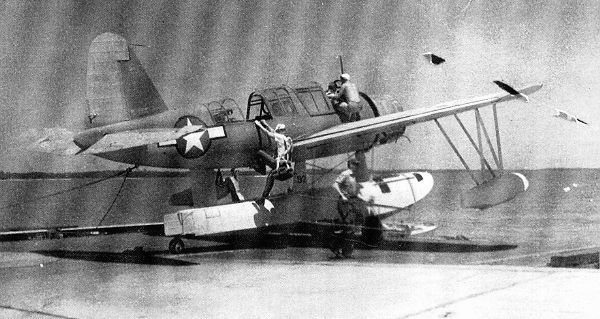 1943 - With its R-985 engine running, OS2U-3 Kingfisher #92 prepares for launch from the seaplane ramp at Biloxi Air Station. The aircraft plane captain assists the pilot while the aviation radioman/gunner climbs into his rear seat position. While there are no depth bombs installed, the release and sway braces are visible. The aft machine gun is installed in the stowed position. Beaching crew members will remove the wheeled beaching gear when the aircraft is afloat on its center pontoon.
1943 - Two Aviation Machinist Mates work on the R-985 engine of OS2U-3 Kingfisher #93 in front of the hangar at CGAS Biloxi. Off to the right in the background is a float mounted N3N-3 used primarily for float operation training of new pilots. CURTISS SO3C-3 SEAPLANES AT BILOXI In June, 1943, the Navy also transferred six Curtiss SO3C-3 seaplanes for Coast Guard operations at Biloxi Air Station. These aircraft were flown to Keesler Army Air Field where they landed on their wheeled gear. After landing, the wings were folded and the six aircraft were towed through town to the Coast Guard Air Station. There, the wheels were removed and a single large center-line float and wing tip outriggers were installed on each aircraft for water operations. Powered by a single Ranger V-770-8 engine, this low-wing, all-metal monoplane with a pilot and aviation radioman/gunner had a range of 1150 miles at 125 miles per hour. However, the S03C-3 with the V-770 engine was under-powered and could not carry depth bombs. A decision was made to use them in a team effort with the OS2U-2s. An early version of air-sea radar was installed on an SO3C-3, which would then act as the hunter, while an OS2U-3, with two 325 pound bombs, would be the killer. While no submarines were destroyed, these effective patrols severely curtailed German U-boat activities in the Gulf. Also that summer, CMDR W. D. Shields, Coast Guard Aviator #34, became the new Commanding Officer at Biloxi.
A Curtis SO3C-3 in flight. The 12-cylinder aircooled V-770 Ranger engine was too underpowered to carry 325-pound depth charges. The aircraft did have an early odel ASB radar. At Biloxi, SO3Cs were operated as the hunter in-pair with a Vought OS2U-3 which carried the depth bombs as the killer on anti-submarine patrols.
1944 - ARRIVAL OF THE PBY-5A Both the OS2U-3s and the SO3C-3s were returned to the Navy in late 1944, and the J4F-1s, JRFs and PBY-5As took over the patrol duties. In addition, the RD-4 V-127, the Hallboats V-166 and V-170 were decommissioned and scrapped. As the year passed, it became clear the war on U-boats in the Gulf of Mexico was being won. The Armed Forces now had much more sophisticated aircraft, anti-submarine weapons, and tactics. The Coast Guard maintained patrols with the J4F-1 and JRF aircraft. These were eventually joined by a more modern amphibian, the Consolidated PBY-5A patrol bomber. Although all the PBYs at Biloxi were Navy-owned, the first two received at Biloxi Air Station were actually built in Canada by Vickers as OA-10A aircraft for the US Army Air Forces. The remaining aircraft were PBY-5As from U.S. Navy sources. The PBY-5A had two Pratt and Whitney R-1830-92 engines, mounted to the parasol mounted 104-foot wing atop an all metal boat type hull. Hydraulically operated tricycle landing gear that retracted flush into the hull for water operations made this a true amphibian. The large wing was partly metal and partly fabric covered. The wing tip floats retracted electrically to the wing tips, reducing drag in flight, and to prevent damage during wheeled landing gear operations. The PBY-5A had a 2500 mile range at 100 miles per hour, crew positions for two pilots, navigator, radar operator, aviation radioman, flight engineer mechanic and two gunners/scanners. There was ample room for survivors. These aircraft were referred to as "Dumbos", "P-Boats", or simply PBYs. As they came from many sources, they also came in a variety of color schemes - all white, all black, all blue, two-tone blue, and two-tone blue and white. Biloxi's station compliment eventually rose to seven PBYs. For much of 1944 and 1945 one was temporarily stationed at the Houma, Louisiana, Lighter Than Air (Blimps) Naval Air Station, and another at Lake Charles, Louisiana, Army Air Field. The aircraft were primarily used for Air Sea Rescue duties.
November
1944 Dealing with accidents
resulting from the increasing number of military
aviation operations over water as the war progressed
had to evolve as well. Much like the early
anti-submarine tactics, the early response plan was
often not much more than, "If you see an accident,
try to give aid and notify someone." Rescue patrol boats were used
as well as aircraft. The most common was the
AVR Boat, a 63-foot vessel with a crew of eight, two
630 Hall Scott gasoline engines, and capable of
nearly 50 miles per hour. Five such rescue
boats were assigned to Biloxi Air Station, two of
which were based in Biloxi. One was stationed
at Galveston, Texas, one at Burwood, Louisiana at
the entrance to the southwest entry to the
Mississippi River, and the last one located in
Morgan City, Louisiana, covering the large marshy
area adjacent to Atchafalya Bay. During the first three months
of 1945, aircraft and personnel from Biloxi Air
Station responded to ten aircraft crashes, rescuing
several survivors during more than 300 flights over
an area covering more than 12,000 square
miles. Although directing surface vessels to
the scene was the preferred means of completing a
rescue, for immediate assistance, or if survivors
were in need of emergency care, open sea landings by
the PBY-5A were made to pick up the survivors.
Open sea landings were always hazardous and often
were used as a last resort.
GENERAL
NOTES ON PERSONNEL AND EQUIPMENT
From its beginning in 1934 until the outbreak of World War II, the personnel manning for Biloxi Air Station, with three to five aircraft assigned, was about 10 officers and 35 enlisted. Eight of the officers were aviators, each having additional duties such as communications, maintenance, supply, administration, etc. Twelve of the enlisted men were yeomen cooks, storekeepers, motor machinist mates, electricians, boatswain mates and seamen. The station was usually manned with one or two of each. In addition, eight radiomen were normally assigned to the radio station "NOX" which operated around the clock. The remaining enlisted men were in direct support of the aircraft - aviation machinist mates, aviation radiomen, aviation metal-smiths, aviation carpenters mates, and enlisted pilots. As usual with the Coast Guard, nearly anyone could perform someone else's job. Everyone was expected to do everything, including being a security policeman or fire fighter should it be needed. When World War II exploded on the scene, operations were stepped up, and the aircraft compliment rose to more than 25 of at least five different types. The additional requirements swelled the manning to about 35 officers and 250 enlisted men by mid-1943. New jobs included aerographers for weather forecasting, aviation electricians, and avionics and electronics technicians for the advanced aircraft systems and radar, as well as aviation ordnancemen, parachute riggers, pharmacist mates, mail clerks, and dental technicians. In 1943, six officer and 25 enlisted SPARS, the women reserve of the Coast Guard, joined the personnel manning, serving at Biloxi until June 1946. By 1944, with the addition of the five AVR rescue boats, the detachments at Houma, Houston and Lake Charles, personnel manning reached more than 330. SPARs assigned to Biloxi during this period included Lieutenants (Junior Grade) G. Columbo and E. Green, supply officers; C. Clegg, public information; and H. M. Adams, pay and disbursing. Enlisted personnel included Radioman L. Meuer, Switch Board Operator, D. Kraft, Yeomen A. M. Wilkerson, L. Ramsey, E. Gearing, M. Haggerty and E. Brown, Storekeepers M. Bales, S. Hall, V. Quan, C. Boggs, Pharmacist mate B. Bryant, Link Trainer Operator, F. Krug. There were also parachute riggers, cooks, mail clerks and others. During 1943, 1944 and 1945 Biloxi Air Station also provided manning for two twin engine JRB-4 and three single engine SNJ-5 aircraft operating at the Civil Aviation Administration, Advanced Instrument and Standardization Center in Houston, Texas. Aviators and pilots attended the Center for extensive training in instrument, night and all-weather flying operations. There were about 18 aviation personnel assigned to this operation. In September 1945, this operation was terminated and the aircraft were returned to Biloxi. As these were land planes, they were maintained and operated at Keesler Army Air Base until transferred to other Coast Guard air stations. Wartime building was needed to accommodate the Air Station's added responsibilities. Construction included a sickbay and dental clinic, barracks, mess hall, storage igloos for depth bombs and other explosives, administrative and operation control buildings, supply warehouses, additional aircraft parking places and taxi ways, and a second seaplane ramp. Official records show that during fiscal years 1943 and 1944, these and the other Coast Guardsmen at Biloxi Air Station made over 7000 flights, flew more than 18,500 hours, traveled 1,715,000 miles searching more than 13,603,000 square miles. At the end of World War II in 1945, personnel manning was reduced almost overnight to about 15 officers and 85 enlisted personnel. Commander R.L. Mellen, CG Aviator #68, was commanding officer. Even though the war was over, many of the new responsibilities remained, and Commander Mellen had to carefully manage balance personnel to the expanded job list. Once again, the Coast Guard found itself back to "everybody doing everything." By mid-1946, manning stabilized at about 12 officers, eight of whom were aviators, each with additional jobs, and about 50 enlisted men. The station operated eighteen aircraft, including five PBY-5A (46502, 48447, 48323, 46618, and 48265), three J4F-1 and 2 (V-198, V-202, and 37765), two JRF-5 (84791 and 04356), and one SNJ-5 (90675). There were also one 30-foot station crash boat and a 30-foot fire boat.
1945 - RESCUE OF THE CREW OF THE USCGC MAGNOLIA One very important air sea rescue occurred in August 1945. On 24 August, at 2330 hours, the USCGC MAGNOLIA, a 41-year old buoy tender operating from Mobile, Alabama was rammed and sunk in the Gulf of Mexico by the S.S. MARGARITE LE HAND, a brand new C-3 cargo ship on its maiden voyage. As a quartermaster on the MAGNOLIA, I soon found myself swimming for my life throughout the long, dark night. The next morning, I was spotted by the pilot of an Air Sea Rescue JRF-5 from Biloxi Air Station which summoned a surface vessel which picked me up. This was my first direct introduction to Coast Guard aviation, and after 10 hours in the water, sharing a single life jacket with two other shipmates, I decided I'd give aviation a try, and was soon given the opportunity to cross train in aviation. I transferred to Biloxi Air Station to begin training as an aviation machinist mate, and one of my first jobs was to assist Plane Captain J.R. Pierce to maintain the five land planes based at Keesler Army Air Base. One of my first training experiences was when Pierce instructed me in how to be a fire guard while he started one of the SNJ-5 aircraft. The SNJ-5 had a single R-1340 engine, and all nine-cylinders exhausted through a manifold to one large exhaust port. Unknown to me at the time, the engine exhaust lit up like a blow torch when first started. When Pierce started the engine that first time, I immediately rushed in with the fire extinguisher and attempted to put out the "fire". Pierce "got my attention," saying that was a normal operation, that it was not on fire, and he would try to start the engine again. This time, however, he inadvertently overprimed the engine, and when it started, the excess fuel ran out onto the ground and began burning. He shouted at me from the cockpit, vigorously pointing to the flames. I could not hear what he was shouting, but having learned my lesson the first time, gave him the okay sign, staying away from what I thought was the "normal operation." Eventually, we put out the fire out with no damage to the aircraft, and Pierce then gave me more detailed instructions on how to "help" during future operations! When not helping Pierce, I assisted with duties on our rescue and fire boats. During a summer night 1946, a waterfront fire broke out in Biloxi, engulfing several large shrimp boats and packing houses. The Biloxi fire department requested assistance from Air Station personnel, and our station fire truck and the 30-foot fire boat responded. The fire boat had four 500 gallon-a-minute water pumps capable of being coupled together to deliver 2000 gallons per minute through a four-inch monitor. We brought the boat in from the seaside, spraying water where it was most needed. There were large amounts of gasoline in 55-gallon drums stored along the docks, and several exploded into damaging, spectacular fireballs as we attempted to disperse and cool them down. We boarded several of the shrimp boats and succeeded in cutting them loose from the dock, and then towing them away from the fire, casting them loose, and returning to the docks to continue fighting the fire. Finally, after many hours, the Biloxi Fire Department got the situation under control and we returned to the Air Station to attempt to clean up and return all equipment to ready status. Our help was rewarded when we were treated to many pounds of shrimp from the "Shrimpers".
December 1945: Loss of PBY-5A 46497
The aircrew of PBY-5A 46497. Photo taken 17 Dec 1945. Al were killed when the aircraft crashed between Dallas and Ft. Worth, Texas, on 18 Dec 1945. Left to right: Hickman; Sailsbury; Jacobson; Linsay; Vallowe. Kneeling: Profitt. From the USCG's accident data base:
A TYPICAL RESCUE AT SEA, 1946 On 28 August 1946, PBY-5A 48447, still in its wartime all black color scheme, launched on a typical medical mercy mission that lasted more than eight flying hours. Pilots LT G. E. McGovern and Chief Aviation Pilot E. P. Ward, with the author and four other air crew members, flew more than 300 miles south into the Gulf of Mexico to land in moderate seas in order to remove a seriously injured seaman from a merchant vessel. Making an off-shore landing was always a hazardous undertaking, and each of us on the crew had an important job to do. As the pilots evaluated the wind and sea conditions to determine how to make the landing, other crew members made the aircraft ready for a water landing. The landing gear was checked up and locked in place. The nose wheel doors were confirmed closed and locked, and any trailing wire antennas were retracted. The auxiliary power plant was started to provide emergency electrical power while on the water and to operate a built-in bilge pump. The crew members took landing positions and tightened seat belts and shoulder harness to prevent being thrown about. The pilots flew the aircraft so as to touch down in a power-on full stall. This ensured that if the sea was too rough or the aircraft bounced back into the air, the crew would have power and control to fly off and try again. That day, our landing was successful and we came to rest in a sea with one and two foot waves. The merchant vessel lowered a life boat with the patient on board, and the life boat approached our PBY. The life boat was rather large, with a steel hull capable of doing serious damage to the aircraft if they were to collide. There was only a small area behind the wing and forward of the tail surfaces where a large boat could safely come alongside a PBY. Since there was a rather choppy sea, the decision was made to inflate one of our rubber life rafts and, with two crew members aboard, float it down to the life boat for transfer of the patient. It was then pulled back to the aircraft, and the patient, strapped into a wire Stokes Litter, was lifted on board the aircraft. When the patient was secured for take off, our crew members deflated the life raft and pulled it on board. Prior to departure from Biloxi, four Jet Assisted Take Off (JATO) bottles, filled with a solid rocket propellant, had been installed onto special brackets on 48447, two on each side just ahead of the blister compartment. Each JATO bottle provided 1000 pounds of thrust for 14 seconds to assist the aircraft in taking off, especially from a rough sea. As the pilots applied full engine power and the aircraft began its take off run, the JATO was electrically fired and the 4000 extra pounds of thrust helped get the PBY safely airborne and on our way to New Orleans. We landed at New Orleans International Airport, transferred the patient to an ambulance for transport to the hospital. A land take off from New Orleans, and a water landing back at Biloxi completed a successful mission. Nearly all medical mercy mission patients by Biloxi aircraft are transported to the Public Health Service Marine Hospital in New Orleans, LA. The Public Health Service Marine Hospitals, located adjacent to major shipping ports, were established to provide medical assistance to Merchant Marine sailors. The hospitals also provided the same service to members of the Coast Guard. Not all missions were as "routine" as the one just described. Following the war, many missions, each lasting for many hours, were performed regularly to search for missing or overdue merchant or fishing vessels. Flying in an expanding square or other predetermined pattern, crew members would visually search thousands of miles of open sea for relatively minute objects. Radar was a big help, but eyeball observation was the primary method. Many a missing person or small vessel were found and rescued when sighted by alert aircrew members. This often happened while a crew was assigned to a non-rescue missions. Scanning became second nature for the crew, and everyone kept a sharp lookout on all missions. Even so, many searches fail to locate the missing subject, despite the experience and effort put forth by dedicated aircrew members.
ABOVE: The pilots of this Coast Guard PBY-5A demonstrate a four bottle Jet Assisted Take Off (JATO) from the waters of Biscayne Bay adjacent to the Dinner Key Air Station (Miami, Florida). Each JATO bottle provides 1,000 pounds of extra thrust for 14 seconds to assist getting the aircraft airborn. This aircraft and the one below are in the post-war paint scheme. 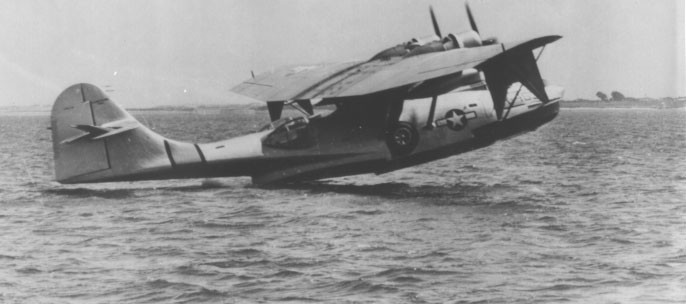
General Muster, 1946. At this time, personnel manning was less than 50 enlisted men and twelve officers. Two J4F-1 and two JRF-5 are seen in the hangar. One additional J4F-1 and three PBY-5A aircraft completed the station compliment.
The main hangar, 1946, with a PBY-5A undergoing maintenance inside. The sing tip of another PBY-5A is just visible at the upper left foreground of the photo. The station's fire truck is to the right of the hangar.  The Sick Bay and Dental Clinic at the far left with the small ship's store. The war-time SPAR barracks was now being used by the remaining male personnel. The original barracks from 1937 (behind the flag pole) was converted to a CPO barracks, mess hall and galley. 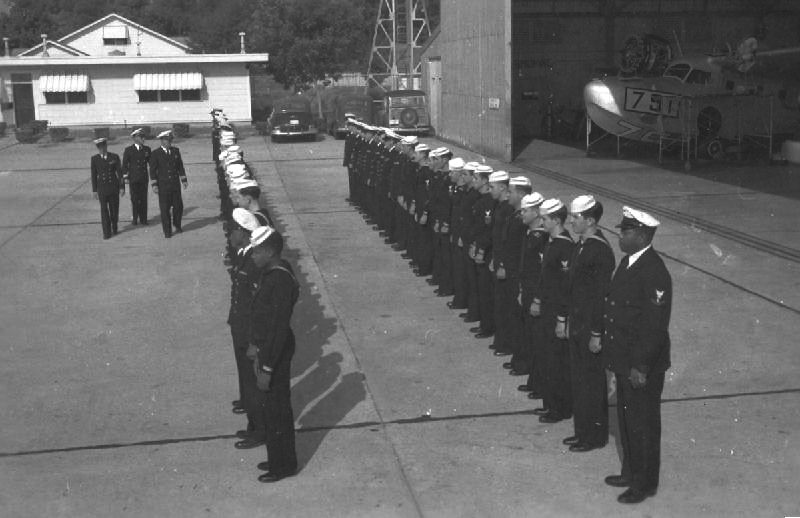
THE AIR-SEA RESCUE PAINT SCHEME One program of the Air Sea Rescue Agency was to develop a distinctive, highly visible color scheme for ASR aircraft. The color scheme was overall aluminum with yellow wing tips, floats, the top of the wing between engines, patches beneath the pilots' compartment, and a band around the aft fuselage. All the yellow markings were bordered with black, and the word RESCUE in black letters, was painted in the yellow area between the engines, and was also painted in yellow along the bottom of the hull. Water operations very quickly wore this belly painting off, and it was soon discontinued. Eventually, all Coast Guard aircraft utilized these colors, as did the Air Rescue Service of the U.S. Air Force, until the 1960s, when both services adopted schemes more appropriate to their missions at the time. Water operations did more than just wear off some paint. As most operations were in salt water, corrosion was an ever-present problem. Following each flight, the aircraft needed to be washed down thoroughly with fresh water. In addition, the wheels were removed and bearings cleaned and repacked, and the multiple disc brakes were cleaned and dried. Particular attention was needed to prevent corrosion of the wing tip float and the landing gear retraction mechanisms.
EPILOGUE Biloxi was one of the smaller Air Stations, designed for pre-war biplanes capable of operations in relatively shallow water. The post-war aircraft were proving larger and heavier than could safely be operated on Biloxi Bay, especially at low tide with a wind from the west. One partial solution was to base the ready rescue aircraft and crew at Keesler Army Air Base about eight miles away, but this proved to be time-consuming and awkward, and plans were made to relocate the assets of Coast Guard Air Station, Biloxi. In March 1947, the Air Station was placed in caretaker status. The hurricane of 1947 did severe damage to the Air Station, especially the wartime built facilities, and the land, hangar, seaplane ramps, original barracks and mess hall were turned over to the city of Biloxi. These were used by elements of the Mississippi Army National Guard for several years. Most of the station's personnel, aircraft and equipment were transferred to other Coast Guard Air Stations. One of the station's aircraft (PBY-5A 46502) and a crew were established as a detachment at Keesler. The crew consisted of LT F. L. Riggs, (a former enlisted pilot - CG Aviator #108 - from the class of 1935), as Officer in Charge, Aviators A. Flanagan and Handley, Enlisted Pilot E. P. Ward, Aviation Machinist Mates J. Green, J. Pierce, and H. Holloway, Aviation Radio Men G. Boggs, J. Brooks, and C. Tornel, and Aviation Ordnanceman C. Fuller. The Keesler detachment continued until late 1966 by which time the Coast Guard established new air stations at Bates Field at Mobile, AL, and the Naval Reserve Air Station at Belle Chasse, LA. About 0600, 30 March 1947,
PBY-5A 46502 of the Keesler detachment responded to
a request for an emergency medical evacuation of an
injured crew member from a freight ship more than
200 miles out in the Gulf of Mexico. Pilots
Riggs and Flanagan, with aircrew members Green,
Pierce, Fuller, and Aviation Radioman J. B. Camet
arrived over the ship about 0900, and made the
necessary preparations for an open sea
landing. A moderate sea with long ocean swells
three feet high required much attention and skill to
make a successful landing and take off. Meanwhile, the ship lowered one of its lifeboats with the patient in a Stokes Litter. The lifeboat had no engine and the crew members rowed across to the PBY. Without waiting for the aircrew to inflate a rubber life raft to use in transferring the patient from the lifeboat to the aircraft, the lifeboat rammed into the left side entrance blister damaging it severely. As the patient was transferred into the PBY, the boat crew allowed the lifeboat to get under the tail plane surfaces, causing additional damage and jamming the aircraft rudder full right. The lifeboat pulled away and returned to the ship, which prepared to get underway. Pilot Riggs told the ship's captain to stand by as the aircraft was in serious trouble, made much worse when the ship drifted down against the bow of the PBY, causing more damage. The sea conditions continued to worsen, the swell increased to six and eight feet. The wind increased to more than 15 knots, and it began to rain heavily. The 165-foot cutter USCGC TRITON, en route from Corpus Christi to New Orleans for a major overhaul, was diverted to assist PBY 46502. It arrived just before dark, and the first order of business was to transfer the patient by the TRITON's lifeboat to the cutter for medical attention. The aircrew continued to make every effort to repair the damaged aircraft, although everyone was seasick as the sea conditions continued to worsen during the night. Late the next day, 31 March, after more than 18 hours of attempting to save the PBY, the decision was made to abandon the aircraft and transfer the aircrew to the TRITON. The PBY sank a short time later and the TRITON proceeded to New Orleans with the patient and the aircrew. Open sea landings were always hazardous! Six years later, in July 1953, PBY-5A 46617, again from the Keesler detachment, responded to a request for an emergency medical evacuation of a seaman with a broken leg on a ship near Head of Passes in the Mississippi River. The PBY apparently struck a submerged obstacle causing the aircraft to water loop, tearing the wing from the fuselage and then sinking. The pilot, Ensign V. Flick, Aviation Machinist Mate J. C. Netherland, and U.S. Air Force medical technician M. L. Sweet were killed in the crash. Three other aircrew men survived. As fate would have it, PBY-5A 46617 had been flying on its last scheduled day of active service - it was to have been replaced that day by a new HU-16 amphibian fresh from the Grumman Aircraft Company. In 1966, after 41 years, the Coast Guard ceased operations at Keesler Air Force Base, and the Coast Guard departed Biloxi. That area of the Gulf of Mexico is still patrolled by Cutters and Life Boats operating from Pasacagoula and Gulfport, MS, and aircraft from Air Stations in Mobile, AL, and Belle Chasse, LA. The site of the original Coast Guard Air Station, Biloxi, is now occupied by a museum of the seafood industry, a nearly forgotten business on a waterfront now wall-to-wall with gambling casinos.
Acknowledgements I want to acknowledge the outstanding assistance provided in this endeavor to some truly great people. J.C. Entrekin, a friend of sixty years who served with both my father and myself, and to his wife Dottie (McCully) who checked many back copies of newspapers and provided many memories and answers. George H. Boggs who, with Henry White, sank the U-166 in WW-II and provided memories and answers. Jones R. Pierce who filled in many blanks along with anecdotes and photos. And who taught me when "a fire is really a fire", among many other things. Mrs. Constance H. McCabe who shared accounts of her father's (J.R. Henthorn) early flying and rescue missions, and truly great photos. Captain Gene Davis of the COAST GUARD MUSEUM OF THE NORTHWEST who has compiled a wealth of Coast Guard information which he is eager to share. Mr. Kenneth Fountain for his Tony Ragusim photos of early times. Norbert W. "Bud" Muench for sharing his memories and photos. Edith Gearing Jenson for memories of the SPAR contributions. Bill Bacon who was the last enlisted man at Biloxi. Jack Shea, Guion Prince, James R. Lee and Stan Sagers who have given me much encouragement. My wife, Patricia, for her typing and help. My son Ted, Major, USAF, Ret., for his encouragment and for the final editing and formatting. Copyright by Ted A. Morris, 2006 |
